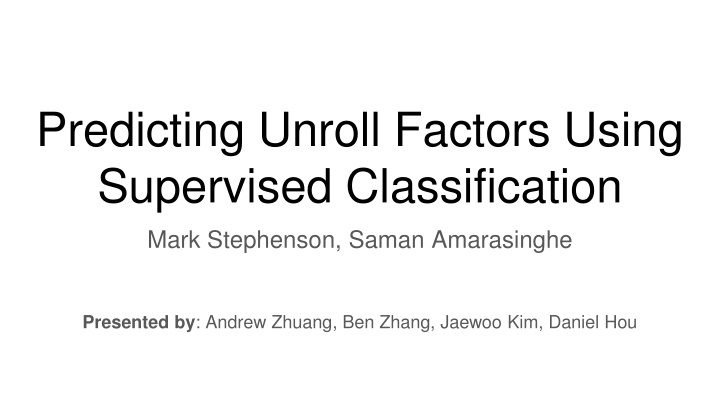
Predicting Loop Unroll Factors Using Supervised Classification
Explore the use of supervised classification in predicting loop unroll factors for optimizing compiler performance. Learn about the motivation, machine learning benefits, supervised learning overview, feature generation, and dataset collection. Discover the advantages and disadvantages of loop unrolling, and why machine learning is essential in complex systems.
Download Presentation

Please find below an Image/Link to download the presentation.
The content on the website is provided AS IS for your information and personal use only. It may not be sold, licensed, or shared on other websites without obtaining consent from the author. If you encounter any issues during the download, it is possible that the publisher has removed the file from their server.
You are allowed to download the files provided on this website for personal or commercial use, subject to the condition that they are used lawfully. All files are the property of their respective owners.
The content on the website is provided AS IS for your information and personal use only. It may not be sold, licensed, or shared on other websites without obtaining consent from the author.
E N D
Presentation Transcript
Predicting Unroll Factors Using Supervised Classification Mark Stephenson, Saman Amarasinghe Presented by: Andrew Zhuang, Ben Zhang, Jaewoo Kim, Daniel Hou
Outline 1. Motivation 2. Supervised Learning Overview 3. Feature & Dataset Generation 4. Multi-class Classification 5. Evaluation 6. Comments
Motivation - Loop Unrolling Advantages Disadvantages Reduced Branch Overhead Exposing Instruction Level Parallelism Code Expansion Increased Register Pressure Loop unrolling increases the aggressiveness of certain optimizations but may adversely affect other important optimizations and reduce overall performance. Goal: Train a ML algorithm how to make informed decisions.
Why Machine Learning (ML)? Efficiency in Complex Systems Automating process of understanding intricate interactions within compiler optimizations Time and Effort Reduction Requires expert knowledge of the system and huge amount of trial-and-error tuning Higher Accuracy ML techniques can predict loop unrolling factors with high precision Adaptability ML models can be quickly retrained to adapt to new architectures or changes
Supervised Learning Overview Set of training examples (xi, yi) xi: feature vector e.g. characteristics of loop yi: label e.g. optimal unroll factor Classifier finds mapping that minimizes training error Hopefully generalizes to new examples Trained offline Compiler runtime: Extract loop features and feed into classifier prediction
Feature & Dataset Generation Collected 38 features, labels determined experimentally from [1 8] Only use loops that run for >50,000 cycles to reduce noise Cache miss could be majority of a short loop
Feature & Dataset Generation Not all features are necessary - find the most informative ones Reduces model complexity and training time Reduces likelihood of overfitting Learning too much about the training data Two methods: Mutual Information Score, Greedy Feature Selection Final dataset is the union of both methods
Feature & Dataset Generation Method 1: Mutual Information Score Measure reduction in uncertainty of feature ? ? given information about u (the optimal unroll factor) Higher is better J is the set of possible values of ? ?
Feature & Dataset Generation Method 2: Greedy Feature Selection 1. Choose the best feature that minimizes training error 2. Choose the next best feature from the remaining features 3. Continue until 5 features (set by authors)
Multi-class Classification Treat unroll factors as classes Use features selected in previous step How to classify multiple classes? Near-neighbor classification Support Vector Machines
Multi-class Classification: Near-neighbor Simple and intuitive Training: construct database of <xi, yi> <feature vector, label> For each novel loop classified, simply take majority label of neighbors within radius (based on L2-norm) (overfitting) Outliers possible
Multi-class Classification: SVM Normally binary Map features to higher dimensional space and find maximally separating hyperplane
Multi-class Classification: SVM Normally binary Map features to higher dimensional space and find maximally separating hyperplane To use in a multi-class context, use output codes
Evaluation Context Ran various SPEC benchmarks 2000, 95, 92 Ran each benchmark 30 times Performance recorded as median runtime for each unroll factor Explored possible unroll factors from 1 to 8
Evaluation: Improvement SVM and NN experience improvement on 19/24 benchmarks SVM: 5% speed up NN: 4% speed up Oracle: 7.2% speed up
Future Work Exploring unrolling factors beyond the experimental range Limit = greatest unroll factor where all loops in training set compile correctly Possible values outside of this range can lead to greater optimization One loop in dataset may limit optimal unroll factor for another loop in dataset Reducing noisy measurements Granularity vs Noisiness Tradeoff Not possible to get rid of noise Possible to reduce noisy measurements Exploring application of ML into other loop optimizations Loop tiling, Strip mining, hyperblock formation in loops, etc.
Comments Simple ML algorithms used with Promising Results What if we used a more complex model? What about Decision Tree or Random Forest model for interpretation? Testing on wider range of loop unrolled factor 5% overall speed up from just loop optimizations Just one optimization Speed up could be even more if we apply models to other optimizations At best, ML is a powerful and time-efficient tool for optimization At worst, ML can help guide engineers towards right direction Can help engineers make sense of the many variables at play






















